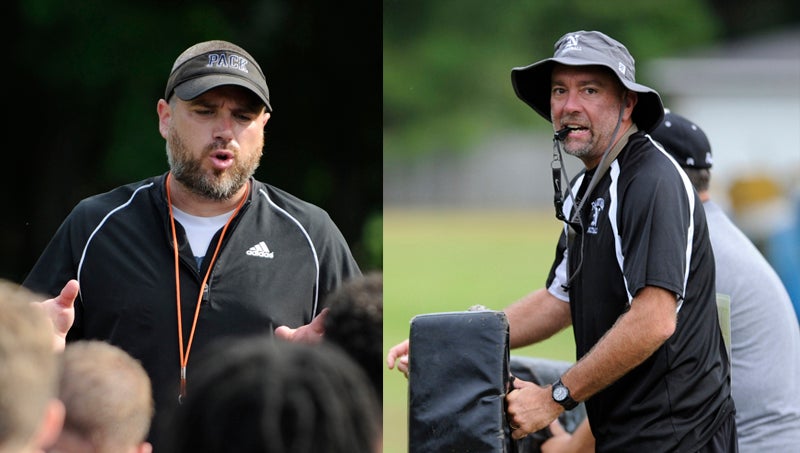Football coaches speak about how they handle hot conditions
Published 9:10 pm Monday, June 18, 2018

- COACH SPEAK: Washington football coach Jon Blank (on the right) and Northside football coach Keith Boyd talk to their respective teams during practice last summer. (Ashley Vansant | Daily News)
Beaufort County and much of eastern North Carolina is experiencing some extreme heat this week, as temperatures reach the 90s and the humidity making it seem even hotter. The National Weather Service has placed the area under a heat advisory due to the extreme conditions.
Being out too long in the heat can have a devastating effect on the body. One may experience heat cramps, heat exhaustion or even heatstroke, if a person’s body temperature reaches 104 degrees or higher. Heatstroke can cause a person to fall unconscious and need emergency medical assistance. It can even be fatal.
Anybody spending time outside needs to be wary of succumbing to heat exhaustion and heatstroke, but athletes playing or training outside are especially susceptible to heat-related illnesses. This time of year football players are putting in hard work to prepare themselves for the upcoming season, including working on their conditioning.
Here’s what Washington football coach Jon Blank and Northside football coach Keith Boyd had to say about how they prepare their players to handle the heat.
Precautions coaching staff takes against the heat:
Boyd: “One thing that helps us is we practice in the mornings. We start practicing at 7 and when it starts getting hot around 9, 9:15 or so, we’ll back off of it if need be. We just keep extra water; make sure to take extra breaks. If it gets hot enough, every 15, 20 minutes we’ll take a break, let them sit down. We have a nice shaded area. This time of the year you’re just trying to get kids in shape and not run them off. Just try to work with the conditions.”
Blank: “The first thing we try to do is we practice really early in the morning. We go from 7 to 9:30 a.m. We try to beat the heat early. Along with that, tomorrow with the heat advisory, even though it’s a little bit later in the day, we’ll go ahead and go without shoulder pads and we may even have to go a couple of drill sessions without helmets and do some walkthrough type things, if it gets too hot out there. Plus, we have our athletic trainers out there, so we have plenty of hydration and then we just add in a few extra water breaks. Probably a water break in the area of every 15 minutes. That kind of takes care of a lot of our hydration issues.”
Speaking to the kids about proper eating and hydration:
Blank: “We absolutely talk to about nutrition and hydration all the time. Actually Coach (Perry) Owens, part of his strength and conditioning is talking about a lot of hydration and nutrition issues. So that’s one of the things we do. We do try feed the kids at quite a few of our practices in the summer, just to make sure that they’re eating right when they’re away from school. But we also talk about the things not to drink. Water is better than Gatorade; we even suggest Pedialyte sometimes if a kid feels like he might be a little bit dehydrated.”
How warning signs like dizziness are handled:
Blank: “We want our kids to tell us what’s going on with them. If something’s hurting, if something’s not quite right, make sure they communicate that with us. Obviously if a kid is feeling dizzy or lightheaded, we want to know that immediately. A lot of times we’ll send them straight over to the trainers, if that’s the case.”
How to balance players pushing themselves but not going too far:
Boyd: “You just have to be smart, can’t be crazy. There’s a fine line there. They have to work through some things. You know you have to trust them to tell you how they feel and to trust them. We go off of what they say. If they’re feeling dizzy or not feeling well, we’ll sit them out. It’s just a trust thing between players and coaches. We do push them but we also know when to back off too. I think that’s important.”





